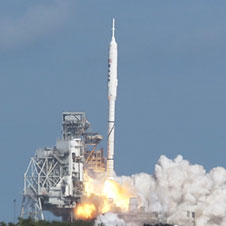Elle s'est envolée...
La video a sauté au moment de la séparation...
Attendant le dépouillement
Bonne journée
La video a sauté au moment de la séparation...
Attendant le dépouillement
Bonne journée
 Re: Vol Ares 1-X
Re: Vol Ares 1-X Re: Vol Ares 1-X
Re: Vol Ares 1-X
 Re: Vol Ares 1-X
Re: Vol Ares 1-X Re: Vol Ares 1-X
Re: Vol Ares 1-X
 Re: Vol Ares 1-X
Re: Vol Ares 1-X
 Re: Vol Ares 1-X
Re: Vol Ares 1-X Re: Vol Ares 1-X
Re: Vol Ares 1-X
Ares I-X Data Continue To Match Models
Dec 4, 2009
After 30 days of data reduction, Ares I-X engineers continue to find fairly close correlation between their computer models and the flight performance of the test vehicle, which was the tallest rocket ever launched.
Flight-control algorithms developed for the operational vehicle "worked extremely well," said NASA's Marshall Smith, systems engineering and integration (SE&I) manager for Ares I-X, and the flight data in general validated the computer models being used to design Ares I.
"I, personally, from SE&I, am very, very pleased with the performance of our (guidance, navigation and control) system; the algorithms that we're testing for Ares I worked perfectly and flawlessly," Smith said. "The predictions matched extremely well. I think that is a key point validating our models that we would use to build Ares I, Ares V."
Factors driving thrust oscillation as the first stage nears burnout, once considered a possible danger to the Orion crew, were lower than expected, as was the roll torque generated by the solid-fuel stage, Smith says. Early modeling of the roll torque drove selection of a 600-lb.-thrust roll-control engine to handle it, which may prove more powerful than necessary.
Thrust oscillation pressure was about a third of what was predicted, Smith said, and the frequency was about half of the predicted value. NASA is designing a heavy set of titanium springs and seat shock absorbers to protect Orion crew exploration vehicle astronauts from thrust oscillation vibrations, but Smith said it is too soon to say whether there will be design implications from the Ares I-X data.
One unexpected result involved the structural damping after a deliberate "twang" engineers imparted to the long, thin vehicle late in flight.
"A quick look shows us it was 20% lower than the simulations," Smith said. "That gives us something to look at more."
Most of the analysis to date has been based on telemetry data, although the test vehicle's data recorders have been recovered and their contents are being added to the analysis. The 30-day results released Dec. 3 will be followed by more thorough analysis in late January and late February.
Recovery of the vehicle's first-stage cameras, and analysis of other data, appear to show the simulated stage separation went as planned, and the two stages did not come into contact as some remote video of the high-altitude event suggested. Analysis of the stage and its onboard data also offered clues to the failure of one of the three main parachutes and the partial failure of another, although finding the exact cause needs more analysis.
As a result of the chute failure, the stage was damaged on impact with the ocean, although its thrust vector control system probably would be reusable, Smith said.
NASA is studying possible follow-on tests that may include an active Orion launch abort system, says Bob Ess, the Ares I-X project manager.